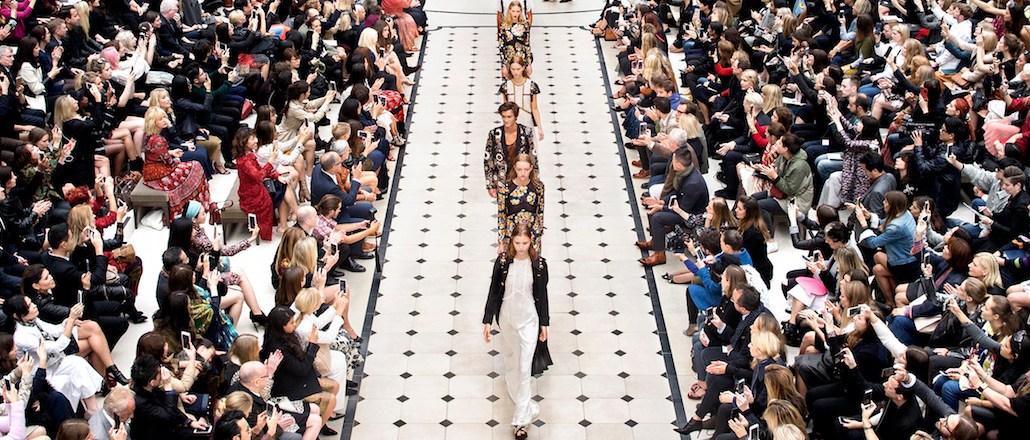
Burberry is making a major change to the way it presents its new collections as a response to the fast-twitch muscles needed for the digital world.
Burberry will no longer show its fall and spring collections six months in advance. Beginning in September 2016, the retailer will show two collections: September and February. The collections will be made immediately available to shop online and in store after they debut, and men’s and women’s lines will also be combined into the same holistic show.
“You create a lot of energy when you do the shows, and the broader these have become — whether it’s livestreaming, Instagramming or showing online — you’re creating all this energy around something,” Bailey told Business of Fashion. “And then you close the doors and say, ‘Forget about it now because it won’t be in the stores for five or six months.’”
The current seasonal timeline of fashion shows has felt outdated for years. The collections that were once meant for only the eyes of the press and wholesale buyers are now broadcast, in real time, for the world to see through online live streams, Instagram, Twitter and Snapchat. “To try to recreate the energy that you created five or six months ago, you’ve got to just question how relevant it is,” said Bailey to BoF.
The fashion industry is feeling the effects. Creative directors have been dropping from their positions at big-name fashion houses over the past year, and the trend continues: Yves Saint Laurent designer Hedi Slimane and Céline’s Phoebe Philo were both said to be leaving their posts in the past two weeks.
Burberry isn’t the first brand to buck the existing seasonal fashion week schedule — but it is the first major legacy brand to do so.
“The fashion show calendar has been under pressure for a long time, and the idea itself of having fashion shows is in question,” said Luca Solca, head of luxury global goods at Exane BNP Paribas. “Now, fashion shows have become a way to communicate to the media. Kudos to Burberry for being the first to recognize this fully.”
Ad position: web_incontent_pos1
Just hours after Burberry’s announcement to condense its runway shows and turn them into consumer-facing events, Tom Ford’s namesake brand followed suit. In September, the designer will show its fall collection, canceling all appointments during the upcoming New York Fashion Week beginning on Feb. 10.
Tom Ford and Burberry are both preceded by smaller, younger brands: millennial designer Rebecca Minkoff will show her spring/summer collection during February’s New York Fashion Week and contemporary French brand Vetements is foregoing the existing schedule to show menswear and womenswear together in one show two months ahead of women’s fashion week. LaQuan Smith, a 27-year-old designer whose items have been worn by Beyoncé and Kim Kardashian, will equip associates with iPads during his NYFW presentation on Feb. 14. Guests can purchase the items shown during the event.
“This really means death for the traditional fashion weeks and the organizations managing it, if they stay rigid,” said Ambika Zutshi, CEO of Fashionbi, a data and insights firm about fashion and luxury industry. “The organizations have no choice but adjust. They can’t really participate in such internal, and powerful, decision making processes of the brands, but what they can do is offer a complementary support system to enhance such decisions.”
In December, the CFDA was said to be working on rethinking the way it runs New York Fashion Week, but no announcement on a decision has been made.
Ad position: web_incontent_pos2
Designers that have yet to shift their seasonal schedules are still adding the digital touches to fashion week. Tommy Hilfiger will have a runway-side photo pit specifically for Instagrammers. Plenty of designers — from Caroline Herrera, to Michael Kors, to Alexander Wang — have begun sharing behind-the-scenes video on Snapchat, while runway live streams live on websites.
“Gone are the days when inaccessible was equal to luxury,” said Zutshi. “Instead of investing in extravagant shows, the brands can invest in aligning the internal management to be more and real-time accessible to the actual interested consumers.”
More in Marketing

In the marketing world, anime is following in the footsteps of gaming
As marketers look to take advantage of anime’s entry into the zeitgeist, they might be wise to observe the parallels between the evolution of anime as a marketing channel and the ways brands have learned to better leverage gaming in recent years.

With the introduction of video ads and e-commerce, Roblox looks to attain platform status
Roblox is expanding into more areas than just ads in 2024. Much like platforms such as Amazon and Facebook have transcended their origins to evolve from their origins as online marketplaces and social media channels, Roblox is in the midst of a transformation into a platform for all elements of users’ virtual lives.

PepsiCo wants to remain a ‘driver of culture’ as it turns to influencers and activations amid rebrand
The soda-maker says it can translate cultural relevance into sales volume.
Ad position: web_bfu